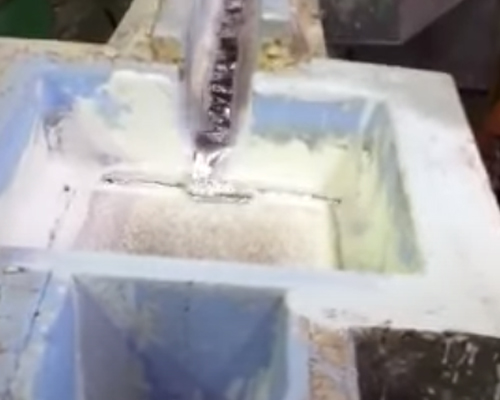In general, two filtering methods are used to remove entrained solids from molten aluminum alloys prior to casting. The most common filter media is an open weave glass cloth screen placed in the metal transfer pan, around the spout, or even in the pool of molten metal at the top of the solidifying ingot. These cloth screens are able to remove only the largest sizes of inclusions from the metal and break easily during use as the glass fibers become very weak at the temperature of molten aluminum.
In another prior art process, molten aluminum is filtered through a bed of free alumina particles, e.g., tabular alumina, but it often suffers from the drawbacks normally associated with bed filters in that it allows too many solids to pass, there is a strong tendency to channel which prevents efficient use, and the pore size of the filter is not easily controlled but rather easily changes under the conditions of use so that even when it is originally of appropriate size, it cannot be effectively maintained. In addition, the metal must be kept molten constantly when the filter is not in use.
Molten aluminum in practice generally contains entrained solids which are harmful to the final cast metal product. These entrained solids generally come from three sources. Some are aluminum oxide particles which are sucked into the liquid stream from the oxide layer floating on its surface, and some entrained particles are fragments of furnace coating, transfer pan, and others parts of molten aluminum handling equipment that are eroded and entrained in the flowing aluminum stream, and some particles are precipitates of insoluble impurities such as intermetallics, borides, carbides or precipitates other aluminum compounds, such as chlorides.

When these inclusions appear in the final cast product after the molten aluminum has solidified, they make that final product less ductile or exhibit poor finish characteristics. Accordingly, it is desirable to remove entrained solids from the stream of molten aluminum before it is cast into a solid body which can be used as such or subjected to forming operations such as rolling, forging, etc. extrusion, etc.
Aluminum alloys filtering processes are accomplished by passing the porous ceramic foam filter medium. Ceramic foam filters offer a simple, reliable and cost-effective method to remove inclusions. Filtering with CFF is a supplement to metal treatment within the furnace, such as fluxing and degassing or inline filtration.

